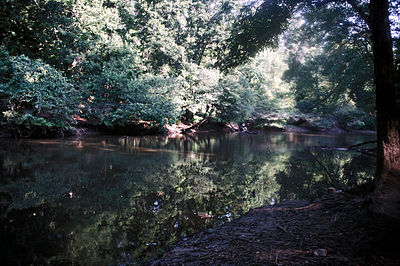 |
| Frederick Steele |
The Red River Campaign in western Louisiana was turning into a
disaster for the Union at the end of April, 1864. Frederick Steele's
movement south was stopped at Camden, Arkansas. There he was running
low on supplies, hemmed in by Confederate forces, and two large
foraging expeditions had been badly defeated at Poison Spring and
Mark's Mill. Therefore he ordered his army to fall back on the
morning of April 27. The Confederate army under Sterling Price and
Kirby Smith started after him and rain began to fall, making the
campaigning hard for both sides. The southern cavalry under Fagan,
who had defeated the Federals at Mark's Mill, were unable to destroy
the Federal supply depots, cut off the Union retreat, or even join
Smith in time to take part in the battle that was fought.
 |
| Jenkin's Ferry Battlefield. Source. |
As Price's men continued their pursuit on the morning of April 30th,
they encountered the Federals behind hastily constructed earthworks
near Jenkins' Ferry. Steele had picked a position to stand a fight to
try to halt Price's pursuit. The place was well chosen, as the front
was only 400 yards wide and the flanks were guarded by natural
obstacles that limited Confederate movements. As infantry arrived on
the field, Sterling Price sent them forward to attack the Federal
position. Although it did not take them long to engage the Federals,
the attacks were too uncoordinated to make any progress. The field
was soon covered in smoke, and the Confederate attacks had to be made
over open ground, covered in mud and water.
 |
| Kirby Smith |
After these fruitless assaults, Kirby Smith arrived with a complete
division from Texas, but he sent them in piecemeal, a brigade at a
time. The southerners took heavy casualties, but were unable to break
the Federal line. Finally by 3 pm the Union forces fell back,
bringing with them all the cannon and wagons they could drag out of
the mud. Although Steele had by no means crushed the Confederate
forces, he was successful in slowing the pursuit and giving his men
time to escape. Both sides suffered heavy casualties. The
Confederates reported 443 casualties, but this did not include any
from the Texas division. The Federals reported loosing 521 men, but
this number also is likely incomplete.
Although the Confederates were not able to destroy either Steele's or
Bank's army in the Red River Campaign, it was still an impressive
success. Both expeditions were defeated, and at the end of the
campaign the Confederates detached 20,000 to send to Johnston's army
in Georgia, and prevent 10,000 Federals from joining Sherman on that
front.
 |
| Battlefield Monument. Source. |






